War Games
Now that War of the Spark previews are over, it's time to start sharing card-by-card design stories. A set with this much flavor packed into its design has a lot to talk about, so let's get started.
Ajani, the Greathearted
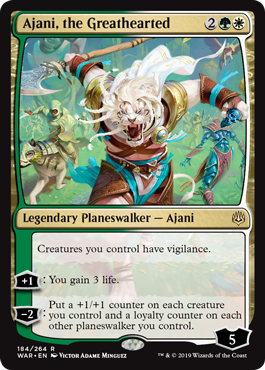
Through all of vision design, Ajani was the uncommon green-white planeswalker with just a -2 loyalty ability that added a +1/+1 counter to target creature. The way we designed the uncommon hybrid cycle was to design the abilities first (as hybrid abilities are hard to design) and then match it to the planeswalker that made the most sense with that ability. Ajani seemed the perfect fit for granting +1/+1 counters as his abilities are about enhancing others.
In set design, it was decided that all planeswalkers should have a static or triggered ability because it was one of the innovations on planeswalkers in War of the Spark and it helped make them feel more Planeswalker-y. Granting vigilance worked for green-white hybrid and was synergistic with the +1/+1 granting. It was then decided that we wanted all the Gatewatch to be rare or mythic rare, so Ajani got moved up and the +1 ability got added. Ajani is a healer, so while a little less synergistic mechanically with the other abilities, it matched Ajani as a character. We also changed his +1/+1 counter–granting ability to now affect all creatures you control and changed the ability so it granted loyalty counters to your planeswalkers. Ajani's green-white uncommon hybrid slot would go to Huatli.
Ajani's Pridemate
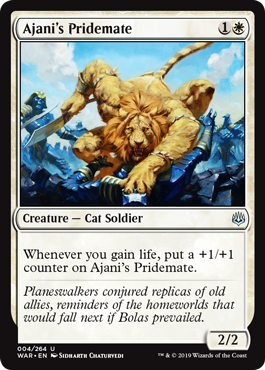
Finally, the story behind Ajani's Pridemate's functional change can be told. Each Planeswalker in War of the Spark had a signature card which represented a spell they might cast. Each signature spell had the Planeswalker's name as a possessive in its title. For most of the signature spells, new cards were created, but the team was on the lookout for reprints that might work. The field was narrow because the card had to be named [Planeswalker Name]'s Blah. Ajani's Pridemate was a perfect fit. Player's liked the card. It fit the set. It tied into Ajani's +2 life gain ability. There was just one small problem.
With the success of Magic: The Gathering Arena, we've been more sensitive to cards that force unnecessary clicks. Having the ability be optional (because of the "may") added an extra click. As this was an ability that you almost never turned down, it didn't seem worthy of the click. There was talk about making a new version of the card, but since it was already named with the possessive, we felt we'd just get complaints from players that we were making them track down a new card they already had. So, we made the choice to errata the newest version to no longer be a may.
This change got applied early online and, as War of the Spark, wasn't public yet—we couldn't explain that the change was to match the new functionality of a printed card. But now, we can, so this was the cause for the change, everyone.
Angrath, Captain of Chaos
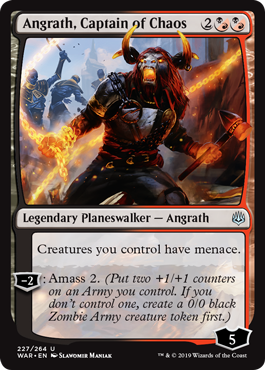
As I explained above, we designed the hybrid planeswalkers first and then looked to see which Planeswalker made the most sense with that ability. For black-red we had three choices: Angrath, Ob Nixilis, and Tibalt. The latter two have always been printed as monocolored cards, but both have personalities that fall into black-red. I believe the original design just had the -2 amass ability. When a static ability was added to the uncommon hybrid planeswalkers, the card was given the menace-granting ability as it's an ability primary in black and secondary in red.
The other issue was because we were using amass, it meant flavorfully the Planeswalker had to be interacting with the Dreadborne army. We chose Angrath because his power is about swaying others temporarily to his side (meaning he could use the army without necessarily working with Bolas) and as he was already black-red there was more expectation for him being black-red than Ob Nixilis or Tibalt. (There were two cycles of uncommon monocolored planeswalkers, which meant if Angrath wasn't hybrid black-red, he would have to be either mono-black or mono-red.)
Arlinn, Voice of the Pack
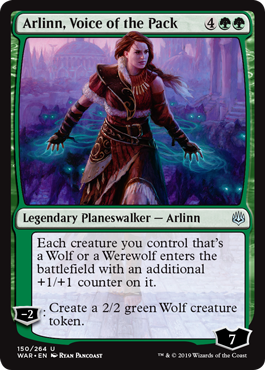
This card started as an uncommon mono-green card with the -2 ability of making a 2/2 creature token. Traditionally, 2/2 green tokens in Magic are Wolves, so the obvious choice for this card was Arlinn. We did talk a little about whether we should use Arlinn, as War of the Spark didn't have double-faced cards, but the Creative team reminded us that she doesn't transform on any plane other than Innistrad. We later added the static ability, as we liked her being a build-around card for Wolves and Werewolves. The set had so many planeswalkers that we were consciously looking for niche designs whenever we could. There was some talk about moving this up to rare, but Nissa and Vivien already had slots, and we didn't want more than two monocolor planeswalkers of any one color at rare.
Ashiok, Dream Render
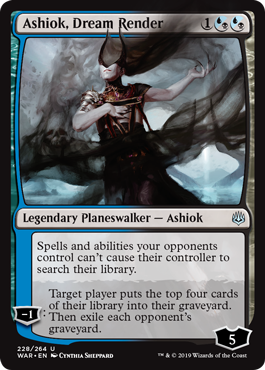
Blue and black are notorious in R&D for having the least amount of mechanical overlap of any two colors. That means designing blue-black hybrid cards is always challenging. The most obvious choice for this card was a milling effect (aka putting cards from a library directly into its owner's graveyard), as it's one of the few abilities that overlap blue and black. Once we made that design, the choice of planeswalker was given; Ashiok is the only blue-black Planeswalker who messes with people's minds. This card was one of the challenges when the static ability got added to all the hybrid planeswalkers. In the end, the Set Design team chose a narrow but library-centric ability. This made the planeswalker a little more niche and helped tie to the two abilities together thematically.
Awakening of Vitu-Ghazi

Bolas attacks with God-Eternals. How can Ravnica respond to that? The answer is by waking up the land of Vitu-Ghazi and having it become a giant Elemental. I believe the earliest version of this design was a land with an activation to wake itself up, but it proved to be a little stronger than we wanted. We then tried doing it as a green sorcery that woke the land up. There was a lot of talk about how big Vitu-Ghazi was supposed to be. In the end, we settled on 9/9—enough to cause the God-Eternals some problems. The land was granted haste because whenever we animate lands, we do that to avoid having to remember which land was played that turn and would thus have summoning sickness.
Casualties of War
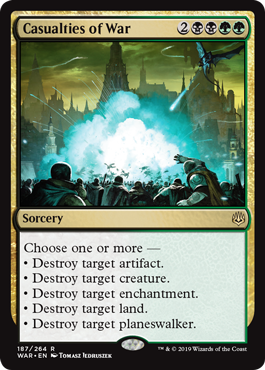
This card came about because we were trying to capture the destructiveness of war. What if we had a card that killed one card of every permanent type? That sounded pretty cool. The earliest template was "Destroy target artifact, creature, enchantment, land, and/or planeswalker." It wasn't clear though that you could pick and choose which ones you wanted to destroy. Also, by writing it out, it made it seem more daunting as the word "destroy" showed up so many times. This is a great example of how the presentation of the text can have an impact on how a card is perceived.
Chandra, Fire Artisan

We knew from the start that we wanted Chandra to be a rare planeswalker (as all the Gatewatch members were). The earliest versions had her doing her normal direct damage–style effects, but it didn't quite feel right. Chandra's storyline in the Bolas Arc had been about her getting trained by Jaya and starting to learn a little subtlety in how she uses her pyrotechnics. We wanted to capture that. In addition, the set had Jaya, also a pyromancer, and we wanted to keep them feeling different.
Chandra had been the first card ever to use impulsive drawing (R&D's nickname for exiling cards that you could play for the turn), so it seemed right to take advantage of that ability. What if her small plus ability let her impulsively draw one card and her ultimate let her draw seven? That sounded cool. But she's still a pyromancer. We needed to find some way for her to deal damage. What if her static ability connected to one of the abilities in a way that resulted in damage? After trying a few different things, we ended up with tying the damage to loyalty counters being removed. The damage was limited to players and planeswalkers as we liked the feel that she was fighting other Planeswalkers. The art strongly hints that she's fighting Dovin, and his Thopters can be seen in the art.
Commence the Endgame
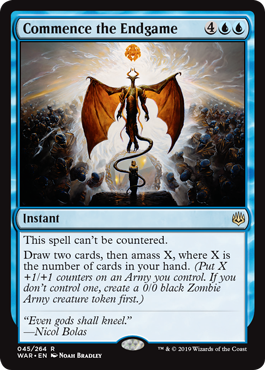
While we, the audience, know the Eternal army is coming, the Planeswalkers in the story didn't. This is the moment where the Eternal army first appears complete with the God-Eternals. We knew we wanted this card to use amass, as that's the mechanic used to represent the Eternal army. To capture the scope of the reveal, we made it a spell that could generate a pretty large army. We added the card drawing for value and then based the value off cards in hand so the draw was connected to the amass ability. The "can't be countered" was added more for flavor than anything else (although, it did help the card play design-wise). Nothing was about to stop Bolas's Eternal army.
Davriel, Rogue Shadowmage
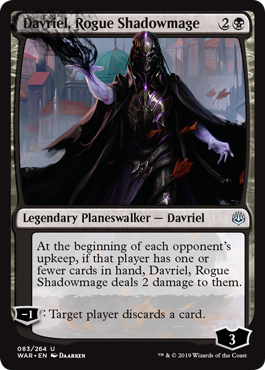
In vision design, we made the three uncommon cycles—two five-card monocolor ones and one ten-card hybrid one. We managed to find characters for all the hybrid planeswalkers but actually had trouble with some of the monocolored ones. For example, let's take mono-black. There are only four characters that have appeared on a mono-black planeswalker card: Liliana, Ob Nixilis, Sorin, and Vraska (and Vraska only in a Planeswalker Deck). Liliana was one of our mythic rares as she's a main character in War of the Spark. Sorin was a rare white-black card, and Vraska was our black-green hybrid. We could use Ob Nixilis, but that left one monocolored black slot without a Planeswalker character. So, we just designed a cool mono-black planeswalker, one that forced discards. When Brandon Sanderson later created Davriel, we realized we had a great fit and turned this card into Davriel. When the card got a static ability, we added an ability that allowed the card to be a build-around for discard decks.
Domri, Anarch of Bolas

This card started as the uncommon red-green hybrid planeswalker with just the -2 fight ability. It ended up being too strong for Limited, so we moved it up to rare. We added the static ability boosting your creatures as it played well in a creature deck and synergized with the fight ability. The plus ability didn't happen until later in design. I believe this went through a bunch of different versions. In the end, Set Design liked making it a mana-generating ability, and red and green are the colors that most often do that. The "can't be countered" rider did two things. One, it made the ability relevant to creatures and tied it in with the rest of the card. Two, "can't be countered" is another ability primary in red and green. It became obvious pretty quickly that this was supposed to be Domri, as he's the most fight-centric of the possible red-green Planeswalker choices.
Dovin, Hand of Control
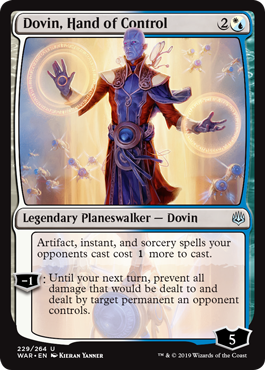
The earliest version of this card made 1/1 white-blue artifact Thopter creature tokens with flying. There were too many tokens being made (and Saheeli really wanted to make artifact creature tokens from Kaladesh, although Servos, not Thopters), so this ended up having to change to something else. Of all the hybrid planeswalker abilities, this is the biggest bend. Blue can do Gaseous Form–style cards that prevent damage to and from creatures and can shrink power with -N/-0 effects, but doesn't normally prevent damage like this. Likewise, reducing mana costs is traditionally more of a blue thing than a white thing. But each color can bend to do the other color's thing, and the overall card felt very Dovin-y, so we let this card through.
Dreadhorde Invasion
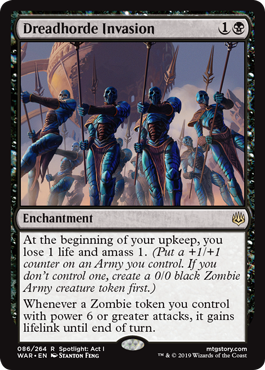
This card shows the Eternal army growing. Its design borrows from Phyrexian Arena and Bitterblossom, enchantments where you lose 1 life each upkeep but get a recurring effect. The last ability is designed to give you a goal to achieve. Once you get a 6/6 Army, is starts being able to get back all the life you spent to grow it.
The Elderspell
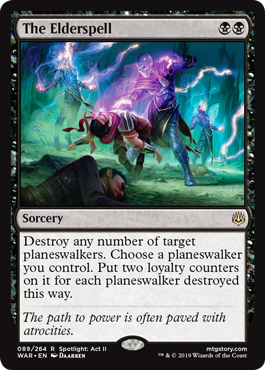
One of the challenges of telling a story in a card set is finding a way to mechanically communicate an important story point. One of the big questions that gets answered in the final chapter of the Bolas Arc was "What exactly was Bolas up to?" Why did he lure so many Planeswalkers to Ravnica and then trap them there with the Immortal Sun? And what exactly did he need the Eternal army for? The answer was he wanted to cast the Elderspell which would allow his Eternal army to suck the sparks out of all of the Planeswalkers (killing them in the process, by the way) and deposit the sparks into Bolas. You see, Bolas once had godlike power, and it was stripped away from him in the Mending. This entire plan was a means to get that power back. Could we convey the Elderspell as a card?
It turns out that not only could we, but it was a pretty sweet card. For starters, it had to kill planeswalkers, the more the better from a flavor perspective, so we let you kill whatever planeswalkers you wanted. We allowed you to choose so you didn't have to kill your own or possibly allies' planeswalkers in a multiplayer game. Then, to represent the sucking away of the spark, you get to put loyalty counters (two per destroyed planeswalker) onto one of your planeswalkers. Yeah, this should be Nicol Bolas if you're doing it flavorfully, but we left it open-ended so you can create whatever story or deck you want to make. And that is how this very cool card came to be.
Feather, the Redeemed
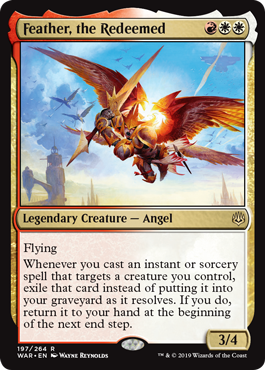
I get a lot of requests for specific characters to get legendary cards. One of the most frequent requests is for Feather, a member of the Boros Legion who was Argus Kos's partner. She's an Angel, so obviously she had to fly. (Interestingly, in the novel, her wings had been clipped, but this story was after she got the ability to fly back.) We wanted a novel combat–oriented mechanic, so she ended up getting an ability that got back any instant or sorcery that targets a creature you control, most often being something used to boost your creature. The delay of not getting it back until the beginning of your end step was from our experience with the buyback mechanic (from Tempest block).
Finale Cycle
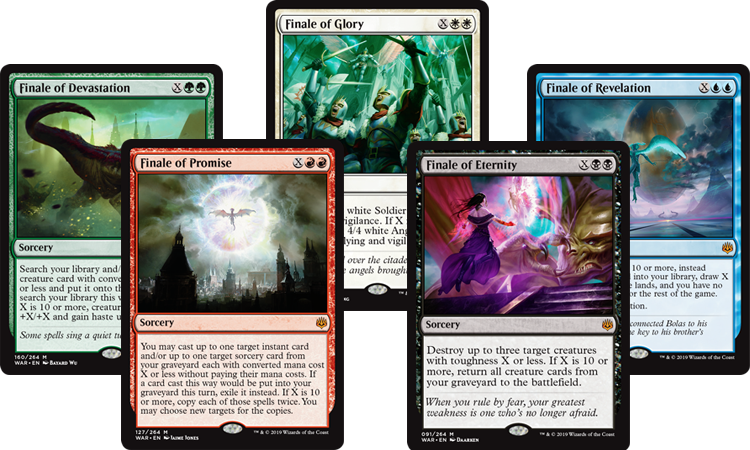
This mythic rare cycle was created in set design as a means to capture the grandiosity of the war. Each was designed as an XMM sorcery (M meaning whatever the color of the card was) that did a scalable effect that kicked into overdrive if you spent ten or more mana on X (and thus twelve or more on the whole spell). The idea behind this cycle was that each spell was useful at any point in the game, but got better the more mana you had.
The white spell illustrates the gathering of the army including the arrival of the Angels. The blue spell shows an important moment where Ugin figures out a key part of what allows the good guys to win. The black spell shows Liliana standing up to Bolas. The red spell shows Niv-Mizzet being reborn. The green spell shows the beasts of Ravnica being brought in to fight.
Fblthp, the Lost and Totally Lost

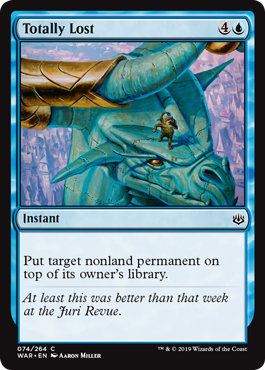
During Unstable design, I went to the Creative team and said, "I'm interested in making a Fblthp card. Do you plan to ever make one in black border?" They said yes, so I left him out of the third Un- set. When War of the Spark vision design started, I went back to the Creative team and said, you said you wanted to make Fblthp. It's normally hard to get legendary creatures into Ravnica sets because we tend to make cycles tied to the guilds, so War of the Spark was the ideal time to make one-of Ravnica characters. The Creative team said, "Do it!"
While designing Fblthp, the card we used as inspiration was Norin, the Wary from Time Spiral.
Norin was also a legendary creature designed from flavor text and like Fblthp, he wanted nothing to do with being an adventurer. We liked the idea that Fblthp would often get lost rather than die. Obviously, he was mono-blue as he's a Homunculus. We gave him a triggered ability that shuffled him into your library (him getting lost) whenever he was targeted by a spell, thus making him hard to kill. We made him a cantrip creature so that you wouldn't lose any card advantage with him. The extra card-drawing condition was created as a build-around feature that allowed players to see if they could make a Fblthp deck, one that often gets him lost in the library and then goes and fetches him. I hope the Fblthp fans have fun playing him.
Flux Channeler
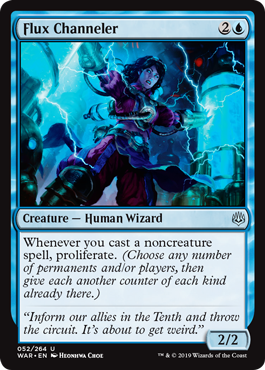
When proliferate first appeared in Scars of Mirrodin block, R&D was hesitant to make too many cards that allowed recurring proliferation. Design had added a whole bunch to the Scars of Mirrodin file, and development greatly reduced the number and as-fan of the proliferate cards, including dropping down the number of cards that could proliferate more than once. Cards like Flux Channeler show that this time around, R&D was willing to be a bit more aggressive with proliferate. One of the reasons for this is that this environment is more about proliferate building things up than tearing things down.
Tug of War
That's all the time I have for today. As always, I'm eager to hear your thoughts on my column, any of the cards I talked about, or War of the Spark in general. You can email me or contact me through any of my social media accounts (Twitter, Tumblr, Google+, and Instagram).
Join me next week for more card-by-card design stories from War of the Spark.
Until then, may you create some War of the Spark stories of your own.
#629: Designing Destruction
#629: Designing Destruction
This is another in my "Designing _____" series where I walk through making basic effects. In this podcast, I talk about making all the various destruction cards.
#630: Five Requests I Ignore
#630: Five Requests I Ignore
37:19
Based on my previous article, I explain why we just can't do some of the things fans request for Magic.
- Episode 628 Greg Weisman
- Episode 627 Empathy
- Episode 626 Magic Golden Rules




